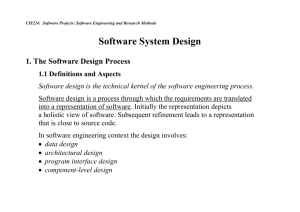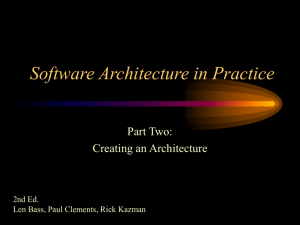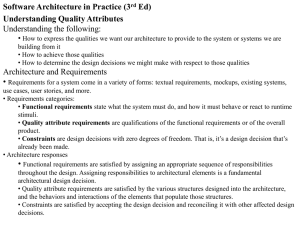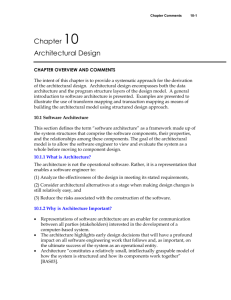What is Software Architecture
advertisement
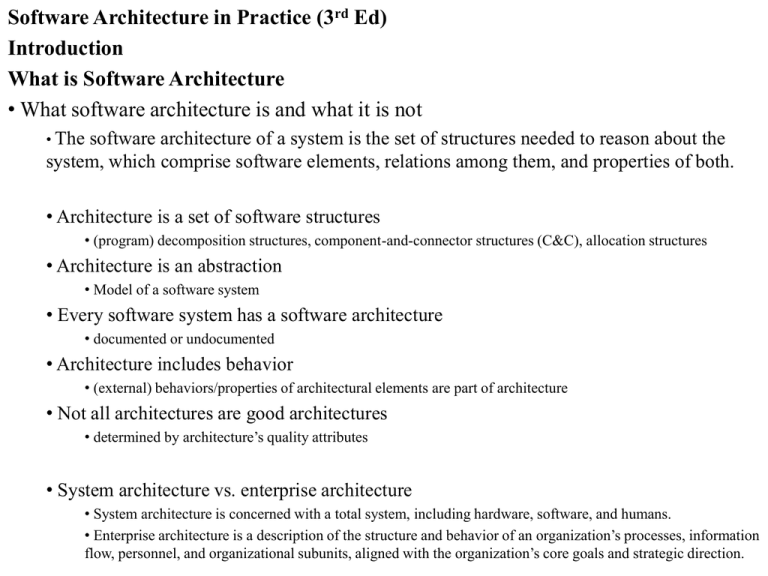
Software Architecture in Practice (3rd Ed) Introduction What is Software Architecture • What software architecture is and what it is not • The software architecture of a system is the set of structures needed to reason about the system, which comprise software elements, relations among them, and properties of both. • Architecture is a set of software structures • (program) decomposition structures, component-and-connector structures (C&C), allocation structures • Architecture is an abstraction • Model of a software system • Every software system has a software architecture • documented or undocumented • Architecture includes behavior • (external) behaviors/properties of architectural elements are part of architecture • Not all architectures are good architectures • determined by architecture’s quality attributes • System architecture vs. enterprise architecture • System architecture is concerned with a total system, including hardware, software, and humans. • Enterprise architecture is a description of the structure and behavior of an organization’s processes, information flow, personnel, and organizational subunits, aligned with the organization’s core goals and strategic direction. Software Architecture in Practice (3rd Ed) Introduction What is Software Architecture • Architectural Structures and Views • A view is a representation of a coherent set of architectural elements, as written by and read by system stakeholders. It consists of a representation of a set of elements and relations among them. • A Structure is the set of elements itself, as they exist in software or hardware. • Three kinds of structures • Module structures • Module structures embody decisions as to how the system is to be structured as a set of code or data units that have to be constructed or procured. • Modules represent a static way of considering the system. • Modules are assigned areas of functional responsibility • Module structures allow us to answer questions such as these: ■ What is the primary functional responsibility assigned to each module? ■ What other software elements is a module allowed to use? ■ What other software does it actually use and depend on? ■ What modules are related to other modules by generalization or specialization (i.e.,inheritance) relationships? • Component-and-connector structures • Allocation structures Software Architecture in Practice (3rd Ed) Introduction What is Software Architecture • Three kinds of structures • Module structures • Component-and-connector structures • Embody decisions as to how the system is to be structured as a set of elements that have runtime behavior (components) and interactions (connectors). • In C&C, the elements are runtime components • Component-and-connector views help to answer questions such as these: ■ What are the major executing components and how do they interact at runtime? ■ What are the major shared data stores? ■ Which parts of the system are replicated? ■ How does data progress through the system? ■ What parts of the system can run in parallel? ■ Can the system’s structure change as it executes and, if so, how? • By extension, component-and-connector views are crucially important for asking questions about the system’s runtime properties such as performance, security, availability, and more. • Allocation structures Software Architecture in Practice (3rd Ed) Introduction What is Software Architecture • Three kinds of structures • Module structures • Component-and-connector structures •Allocation structures • Embody decisions as to how the system will relate nonsoftware structures in its environment (such as CPUs, file systems, networks, development teams, etc.). • These structures show the relationship between the software elements and elements in one or more external environments in which the software is created and executed. • Allocation views help us answer questions such as these: ■ What processor does each software element execute on? ■ In what directories or files is each element stored during development, testing, and system building? ■ What is the assignment of each software element to development teams? Software Architecture in Practice (3rd Ed) Introduction What is Software Architecture • Relating structures to each other Software Architecture in Practice (3rd Ed) Introduction What is Software Architecture • Architectural Patterns • In some cases, architectural elements are composed in ways that solve particular problems. The compositions have been found useful over time, and over many different domains, and so they have been documented and disseminated. These compositions of architectural elements, called architectural patterns, provide packaged strategies for solving some of the problems facing a system. • Example module type pattern: Layered pattern • Example C&C type patterns: • Shared-data (or repository) pattern • Client-server pattern • Example allocation type patterns: • Multi-tier pattern (software-to-hardware allocation) • Competence center and platform (work assignment structure) • Competence center: work is allocated to sites depending on the technical or domain expertise located at a site. • Platform: one site is tasked with developing reusable core assets of a software product line, and other sites develop applications that use the core assets. What makes a “Good Architecture” • Process recommendation 1. The architecture should be the product of a single architect or a small group of architects with an identified technical leader. 2. The architect (or architecture team) should, on an ongoing basis, base the architecture on a prioritized list of well-specified quality attribute requirements. 3. The architecture should be documented using views. The views should address the concerns of the most important stakeholders in support of the project timeline. 4. The architecture should be evaluated for its ability to deliver the system’s important quality attributes. 5. The architecture should lend itself to incremental implementation, to avoid having to integrate everything at once (which almost never works) as well as to discover problems early. • Product/Structural recommendation 1. 2. 3. 4. 5. 6. 7. 8. The architecture should feature well-defined modules whose functional responsibilities are assigned on the principles of information hiding and separation of concerns. Quality attributes should be achieved using well-known architectural patterns and tactics. The architecture should never depend on a particular version of a commercial product or tool. Modules that produce data should be separate from modules that consume data. Don’t expect a one-to-one correspondence between modules and components. Every process should be written so that its assignment to a specific processor can be easily changed, perhaps even at runtime. The architecture should feature a small number of ways for components to interact. The architecture should contain a specific (and small) set of resource contention areas, the resolution of which is clearly specified and maintained.
